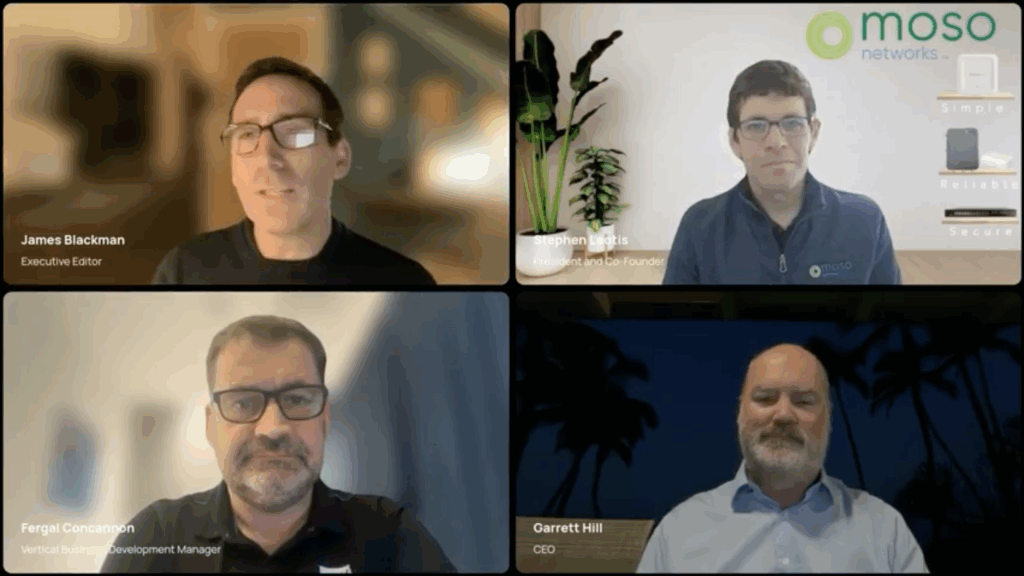Private 5G has long promised Wi-Fi-like simplicity for industrial networks. At Industrial Wireless Forum, Moso Networks and partners Druid Software and X2nSat argued that promise has finally arrived: plug-and-play blueprints, three-minute deployments, and easily scalable 5G for enterprises of any size.
In sum – what to know:
Copy-and-paste – Moso Networks says private 5G has moved beyond proofs-of-concept, offering repeatable, off-the-shelf blueprints that deploy in minutes rather than weeks.
Hidden complexity – Druid’s core and Moso’s RAN simplify configuration for OT teams, keeping 3GPP complexity under the hood while enabling enterprise-friendly operations.
Real-world proof – with X2nSat, they are delivering mission-critical 5G for US utilities using compact RAN units and satellite backhaul, as alternatives to heavyweight systems.
How long has this market been trying to devise a definitive set of design blueprints to facilitate the easy deployment and scale of private 5G systems in Industry 4.0? For ages, right? Well, maybe it is getting somewhere, finally. This was the subject of another good session at Industrial Wireless Forum a couple of weeks back, and the response from US-based Moso Networks to a final question, about whether some kind of mythical plug-and-play of-the-shelf industrial-grade private 5G blueprint is really out there, sought to conclude the whole matter. Yes – was the answer.
Let’s replay the conversation. So for the record, cut to the chase, because this industry has talked about an 80/20 rule for modularity versus bespoke design and integration for years: is the idea that you can copy and paste 5G across enterprises and industries a promise or an ambition? Is this a 1.0 version or a final blueprint? Stephen Leotis, president and co-founder at Moso Networks, responds: “We are beyond 1.0; version 1.0 is let’s-try-it-out-at-a-site, kind of just-past beta. We’re delivering these networks with the partners to many different verticals.”

He goes on: “It is a real thing today; copy-paste blueprints. [And] an opportunity for any company of any size that wants to test or scale private 5G. We can help enterprises get started – as a managed service provider delivering networks to enterprises. In turn, enterprises can get access to this technology very, very quickly. We want enterprises to get past that barrier. They can get started with this technology to solve these problems, and it doesn’t have to take millions of dollars to do it. It can be very affordable and very quick.”
US-based Moso Networks offers all-in-one RAN access points that pair with sundry core network solutions for “Wi-Fi-like” private 5G deployments. It works mostly in the CBRS market in the US, and claims ‘mission-critical’ deployments with large and small enterprises – including campus deployments at critical grid chokepoints for unnamed utilities on the US east and west coasts, as discussed during the session. These utility projects have been undertaken with Ireland-based core network provider Druid Software and US satellite and cellular integrator X2nSat.
Both Druid Software and X2nSat are on the panel with Leotis at Industrial Wireless Forum – in the forms of Fergal Concannon, vertical business development manager at the former, and Garrett Hill, chief executive at the latter. Together, they make the case. Concannon says: “The market needs vendors to simplify the configuration of the RAN, and also the core – so it is something enterprises can use. We’ve done that at Druid over the years… We’ve seen how fast you can stand-up the Moso RAN in comparison to other vendors that we’ve worked with over the years.”
As a point of reference, RCR Wireless is about to host another session at Industrial Wireless Forum with Druid Software, to talk about time-sensitive networking (TSN) on private 5G – about complexity, rather than simplicity, in the core network. So what gives? Concannon responds: “Yes, but even with that, it has to be [usable] by OT staff. It’s complex under the hood, but quite straightforward on top. We are supporting all the features through the backend of the core, but we are presenting it so the end users are not lost in 3GPP terminology when they look at a screen.”
Leotis says the same. “We have been focused on building a solution that is as simple as possible – which is as plug-and-play as possible. Which means removing the complexity of cellular deployments – so extracting all of the 3GPP jargon-items – and getting networks up in a matter of hours, and not weeks or months. We’ve been working on this idea of repeatable networks… [in order] to eliminate those barriers from day-zero installation through to day-two management.” He has an anecdote to illustrate this new 5G simplicity – shorn of jargon, pre-integrated for set-up.
“We have some customers doing pop-up networks for broadcasting and other on-demand scenarios, which have had networks that take 40 minutes to come up, and they fire up our system in three minutes – which is the time from powering-on to connecting devices. We’ve had this incredible a-ha [response], where you walk into meetings, put an AP on a desk, and fire it up… We are simplifying the architecture with partners like Druid – going from large backend servers and complex LAN integrations to just an access point, or an access point plus a small compute [function].”
Hill at X2nSat is the boots-on-the-ground in Industry 4.0, effectively – and for this trio, and this panel. How does the Moso/Druid set-up compare with every other system in the market? “The legacy vendors [traditionally] provide large and complicated software and hardware… [But] enterprises are focused on compatibility, predictability, security… Moso and Druid know this space… An enterprise might not have a team of 400 people managing the RAN, right? It could be a part-time job for one IT person… The expectation is the technology is similar to what they already use.
“[So] there are really two different types of [private 5G] products, which come from different perspectives, and you can start very small with [this system]. It doesn’t have to be a multi-million dollar initial-buy; you don’t have to think about every aspect of cellular from the start. You can just jump in and start doing things, and then evolve as you go. I think when we talk about simplicity, it is more about flexibility – in that you don’t have to [decide everything on] day-one, and then get trapped a year into your deployment [because you need a] major forklift upgrade.”
So what about those utility projects with Moso and Druid, split across both coasts? Hill explains: “We are dealing with a number of utilities on both sides. They have remote areas with cellular assets with no cellular coverage. We’ve put in LEO satellite systems for backhaul, attached to outdoor cellular; think of a lake or a powerhouse, or a dam – for security cameras or voltage regulation, or door and gate access. And it is a nice solution, covering a service area of [anywhere between] a few acres and a few kilometres, beyond what they can serve with Wi-Fi.”
Leotis chimes in. “These industries – energy, oil and gas, utilities – traditionally need large-scale coverage. But… [they also have] assets in different locales, and don’t historically have any cellular expertise. So we’re deploying a mission-critical redundant system for connectivity over the X2nSat satellite connection. It is simple, but it also doesn’t strip away all of those mission critical functions – redundancy, data security, sovereignty; all this stuff you’re getting with these networks.”
He adds: “Hopefully the market starts to understand that it doesn’t need these heavy-lift macro-derivative products; that they can deploy these all-in-one radio access points, maybe with some minimal compute on site.”

